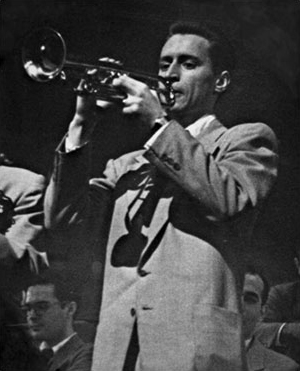
B: Feb. 6, 1927
D: Jan. 23, 1974
Instrument: Trumpet
One of the brightest stars to come out of Worcester, Fagerquist grew up in a musical family on Grafton Hill. His mother played piano and his dad played the harmonica. He began playing trumpet as a young child. By the time he was 13, he was featured in the city’s best bands. At 17, he was recruited to play with the Gene Krupa Orchestra. He went on to become a star soloist with Artie Shaw, Woody Herman, and Les Brown.
Education: Worcester Public Schools
Private Instruction: According to his sister, Evelyn Bowler (still living in the city), Don studied trumpet as a child at Carl Seder’s on Front Street and with Miss Twist at North High School.
Awards: In 1954, Fagerquist was chosen the No. 5 trumpeter in the country by Metronome magazine. Those ahead of him were Chet Baker, Dizzy Gillespie, Shorty Rogers and Roy Eldridge.
Playing experience: At 13, he joined the orchestras of Bob Pooley and Dol Brissette, two local bands. In 1943, Fagerquist worked with Mal Hallet, who led a regional band. Worked with Krupa off and on between 1944 and ’48. He then started his own group, which featured singer Anita O’Day. He later became a soloist with Artie Shaw, Woody Herman and Les Brown. In 1956, he joined the staff of Paramount film Studios. From this time forward, he became more known for his session work, although he continued to record jazz until his untimely death at 47. He died at his home in California.
Discography: Don Fagerquist, Music to Fill a Void; Manny Albam, I Had the Craziest Dream; Laurindo Almeida, Ole Bossa Nova; Chet Baker, Pacific Jazz Years; Benny Carter, All of Me; Hoagy Charmichael, Hoagy Sings Charmichael; Dave Pell, Mountain Greenery. (Although long out of print, he made a number of recordings for Decca, Contemporary, Coral, Capitol, Bethany, MGM and Kapp records.) He can also be heard on Barbara Streisand’s hit “On a Clear Day.”
Press Quotes: "Instrumental jazz, with all of its departmentalism, is forever rooted in the fundamentals of pronounced rhythm and emotional interpretation. In this tradition, Don Fagerquist ranks close to the 10 or 12 stylists who have broadened its scope in jazz. His musical democracy is on display, firmly supported by eight aggressive believers." – from the liners notes to Music to Fill a Void, Fagerquist’s only album as leader.

